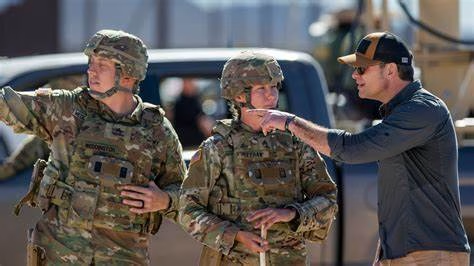
The U.S. Department of Defense has officially designated a second National Defense Area (NDA) along the U.S.-Mexico border, signaling a broader expansion of military involvement in immigration enforcement. This new enforcement zone stretches 53 miles eastward from El Paso, Texas, to the rural border town of Fort Hancock, according to Maj. Geoffrey Carmichael of the Joint Task Force-Southern Border, it falls under the jurisdiction of Fort Bliss Army Base.
FLASHBACK Hegseth has long been thinking of protecting the Southern Border:
The area will now be patrolled by U.S. military personnel, who have been authorized to detain individuals who cross the border illegally and transfer them directly to the Department of Homeland Security (DHS) for further processing. This step is part of a growing trend to integrate military infrastructure into immigration control mechanisms, even as illegal border crossings have fallen to their lowest levels in decades.
Gen. Gregory Guillot, commander of U.S. Northern Command, stated that the move is intended to enhance border security capabilities. “The establishment of a second National Defense Area increases our operational reach and effectiveness in denying illegal activity along the southern border,” Guillot noted in a formal statement.
This follows an earlier military designation along the New Mexico border, where the Defense Department now oversees a 60-foot-wide strip of land. That initial National Defense Area has already led to more than two dozen migrants facing dual misdemeanor charges—not only for illegal entry but also for trespassing on federal military property. Legal experts say this dual-charge approach could set a precedent for how immigration violations are prosecuted in military zones.
Defense Secretary Pete Hegseth emphasized that the new designation turns a typical border crossing into an incursion onto federal military land. “Any illegal attempting to enter that zone is entering a military base, a federally protected area,” Hegseth said. “You will be interdicted by U.S. troops and Border Patrol.”
Critics, however, argue that these moves push the boundaries of the law. The Posse Comitatus Act of 1878 explicitly restricts the use of federal military personnel in civilian law enforcement roles without congressional authorization. However, legal analysts suggest that the administration navigate this restriction by designating these areas as part of military bases.
Geoffrey S. Corn, director of the Center for Military Law and Policy at Texas Tech University and a retired Army lieutenant colonel, called the strategy “ingenious” in using existing legal loopholes. “The Trump administration has found an ingenious way of using the military for immigration enforcement without asking Congress for permission.
The Posse Comitatus Act of 1878
The Posse Comitatus Act was passed in 1878. It limits the use of the U.S. military in domestic law enforcement. The law was a response to federal troops being used in the South after the Civil War.
The Act says the Army—and later the Air Force—cannot act as police inside the U.S. This is only allowed if Congress or the Constitution gives clear permission. The goal is to protect civil liberties and keep the military separate from civilian law enforcement.
The law does not apply to the National Guard when under state control. It also does not cover the Navy or Marine Corps, but similar rules are in place for them.
There are exceptions. One is the Insurrection Act. This allows the President to use troops during rebellion, major violence, or when laws cannot be enforced.
The military can still help in other ways. For example, they can support disaster response or help with drug enforcement. But they cannot directly arrest people or act like police.
In recent years, the law has been debated. Some say military support at the border breaks the law’s intent. Others argue support roles like surveillance are legal.
The Act remains important today. It helps ensure that law enforcement stays under civilian control. It draws a clear line between military power and domestic policing.
